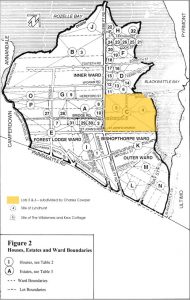
by Rodney Hammett, October 2021, from Bulletin 8/2021
Originally part of Lots 4 and 5 in the 1828 subdivision of Glebe, the Lombard St we see today was created in three phases: in 1900, 1908 and 1994.
Phase 1 – 1900
Thomas Cudbert Harington had in 1828 been the top bidder for both Lot 1 at £12 3s per acre (eastern side of Glebe Point) and Lot 5 at £13 per acre, however he decided not to proceed. Eventually it was public servant Charles Cowper, who had purchased Lot 6, who also purchased Lot 5 and it was he who on-sold the 43-acre site.1
Lyndhurst was established by James Bowman (1784-1846), naval surgeon and pastoralist, on a 36-acre site he purchased from Charles Cowper.2 The house was built progressively from 1833 to 1837 on the high ground overlooking Blackwattle Bay which over time became a swamp and eventually the Wentworth Park we know today (the circled 4 in the figure to the left).
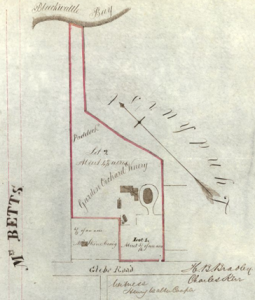
The Wilderness was constructed as a family home by John Betts (1805-1846), storekeeper, merchant and pastoralist3 on a six-acre site he purchased from Charles Cowper in 1832. The land with improvements is shown outlined red in the diagram from Book 28 No 569, at NSW Land Registry Services (Figure 2 below). You can see here the Lyndhurst property on the eastern boundary.
This Betts land was sold by his executors to William Moffitt in 1853 who then leased The Wilderness. Following Moffitt’s death in 1874 his executors arranged for the construction of Palmerston Terrace on Glebe Point Rd in 1882, at which time The Wilderness was demolished.4 On the land beyond and east of this terrace, new roads and lots were planned in a subdivision that was first offered for sale in late 1900.5 A later advertisement in October 1901 shows the subdivision and street layout, plus the Palmerston Terrace and shaded lots that had already been sold (Figure 3). One of these newly created roads was Lombard St.
In 1901 tradesmen were in big demand here as houses emerged from the gardens, orchard and rubble of The Wilderness estate. Keen builders including George Logan, Charles Coulton, John Howard Brown, Robert Coupland Winn and Robert Chambers had each secured numerous lots for their future workload. And it was coming thick and fast because at the same time the final subdivision of the Toxteth Park Estate was being sold and developed at The Point.
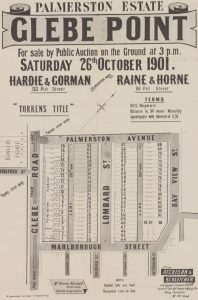
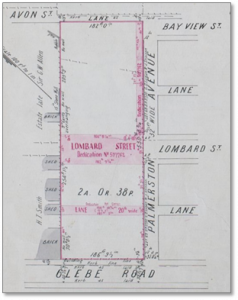
Phase 2 – 1908
On the northern boundary of The Wilderness was Lot 4 of the 1828 subdivision, which together with Lot 3 had been purchased by Captain William Dumaresq. He sold a four-acre parcel adjoining The Wilderness to John Betts in January 1835.6 Here Betts, on a lot that extended from Glebe Point Rd down to Blackwattle Bay (now at about Taylor St), had a cottage built for his widowed mother and sister, both named Harriott. This was named Kew Cottage after the London suburb where his mother had been married.7
Much has been written of this cottage during the period up to the death of Harriott Betts, the unmarried sister of John, in 1889 and then its changed use as a Diphtheria Ward for the first Children’s Hospital –which is now the site of the Glebe Library. The cottage was incinerated as a public health measure in 1907. (See also Bulletin 7/2016 and Villas of Glebe & Forest Lodge pre-1870, 11 Kew Cottage).
By this time the land on which the cottage had stood had been reduced to just over two acres and in March 1908 it was owned by Louis Rich of Sydney, a gentleman. It was he who subdivided the land and extended Lombard St by dedicating land through the site as shown in the diagram in the Certificate of Title (see Figure 4). The cottage had stood where the Lombard St was extended.
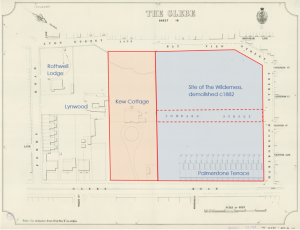
Phase 3 – 1994
On the land north of Kew Cottage was Lynwood, a house constructed in about 1851 and shown with nearby houses in the 1888 survey of Glebe.
In a previous Bulletin article (07/2020) the demise of Lynwood and the use of that site plus land previously part of the Kew Cottage site by Meloy Carriers was discussed. Mirvac purchased the Meloy site in 1992 and then over two years developed the townhouses and apartments we see today. By 1994 Lombard St had been extended into the Mirvac development.
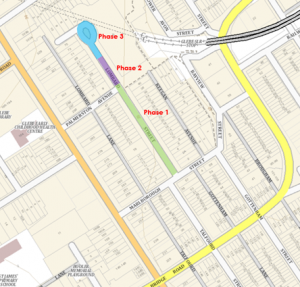
NOTES: 1. LHJ No. 23; A Semi-Rural Retreat, Places, People and Society in Glebe 1828-1861, Part 1, Table 1; 2 See also Australian Dictionary of Biography; https://adb.anu.edu.au/biography/bowman-james-1812; 3 LHJ No. 23; The Wilderness, p.24; 4 LHJ No. 23; p. 25; 5 SMH; Sat 20 Oct 1900, p. .17 [col 6]; 6 NSW Land Registry Services; Book G No 908; 7 LHJ No 23; Kew Cottage, p. 26.










One comment. Please add yours.
This is so interesting as I am related to John Betts and the Harriet Betts named here. It is hard to imagine owning that property now!